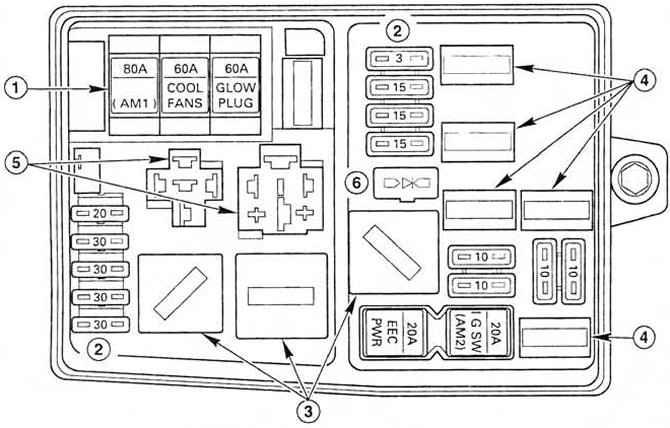Note: Before disconnecting and replacing fuses or relays, turn off the ignition and turn off the relevant electrical circuit. If you need to remove the fuse or turnip, disconnect the negative battery cable. Connect the battery as directed chapter 5.
1. Fuses are designed to break the circuit at a certain value of current with a circuit to protect components and wiring that can be damaged if the rated current is exceeded. Exceeding the rated current is usually due to a circuit fault, often caused by a short circuit (see paragraph 2). The main fuse box, which also contains some of the relays, is mounted below the dash on the passenger's side, (see fig. 3.1).
 Pic. 3.1. Component location of the main fuse box.
Pic. 3.1. Component location of the main fuse box.
1. Clip for extracting fuses/relays
2. Diode
3. Electrical connectors
2. The central timer module is installed on the bottom of the main fuse box. This module contains the timing circuits for the rear defroster, interior lights, and wiper breaker. This module activates a warning buzzer/beeper when you leave the vehicle without turning off the lights, or when an automatic transmission equipped vehicle is parked and the transmission selector is not in the "R".
3. An additional fuse box is installed in the engine compartment at the front left. To access it, you need to unfasten and remove the cover. The extra fuse box also contains some turnips (see fig. 3.3). Each circuit can be identified by the numbers printed on the cover of the main fuse box and the cover of the additional box, fuses (from her inside). For a list of circuits protected by fuses, see Technical requirements. A plastic clip is fixed on the main fuse box and on the inside of the cover of the additional box. It should be used to remove fuses and relays.
 Pic. 3.3. The location of the components of the additional fuse box.
Pic. 3.3. The location of the components of the additional fuse box.
1. Fuses 1...3
2. Fuses 4...8, 11...14
3. Relay R2, R5, R6
4. Relay R7...R11
5. Relay sockets R1 and R4
6. Diode
4. To remove the fuse, pull it out of its holder using the plastic clip. Pull the fuse out of the clip by pulling it sideways. If the fuse is blown, then you will see that the wire inside it is broken (see fig. 3.4).

5. Always replace the fuse with a new one of the same rating. Never install a fuse with a higher rating and do not replace it with wire or foil to prevent damage and fire. The fuse rating is stamped on its head. If the fuse blows again after replacement, be sure to find out the cause of this before installing a new one.
6. Spare fuses with various ratings are available in the lid of the accessory box. Please note that if you do not use the car for a long time, the fuse 34 in the main box must be removed in order to prevent the battery from discharging when the auxiliary electrical components are turned on.
7. Relays are electrically controlled switches installed in certain circuits. To remove the relay, pull it out of the appropriate socket. Each turnip in the fuse box has a plastic rod on the upper surface, for which the relay must be pulled out with a plastic clip. For a list of relays and their functions, see Technical requirements (see fig. 3.7).

8. If the component in which the relay is installed is defective due to the relay (how do you suppose), then when the circuit is running, listen to the operation of the relay. When the relay is energized, a click is heard. If the relay works, then the malfunction is due to the components or wiring of the system. If the relay is not receiving power (click is not heard), which means that the control voltage is not supplied to the turnip, or the relay itself is faulty. When troubleshooting, pay attention to the contacts of the relay socket. You can check the turnip by installing a working relay instead. At the same time, be careful, some relays are similar in appearance, but are designed to perform different functions.
9. The central timer module is installed on the bottom of the main fuse box. This module has a self-diagnosis function. Note that diagnostics are not implemented if the rear window defroster is defective.
10. To turn on the system, press the rear window defroster button with the ignition on. Then release the button. Turn on the light switch, the washer pump switch, and all the switches located on the doors in turn and check that the buzzer confirms the correct input signals.
11. After that, set the wiper on lever to the position corresponding to the intermittent operation mode. Monitor the output signals by turning on the same switches.
12. The self-diagnostic function is disabled when the ignition is turned off and re-enabled when the ignition is turned on.
Visitor comments